| |
Unprovoked White Shark Attacks on Surfers
There were 41 confirmed unprovoked shark attacks on surfers along
the West Coast of North America during the Twentieth Century, which
represented 38% of the total reported cases. The White Shark
was determined to be the causal species in all but two. It
has been suggested that White Shark attacks on surfers are the result
of the attacking shark mistakenly identifying the surfer for a pinniped.
Predatory attacks by White Sharks on pinnipeds have been described
from numerous locations worldwide, including the Farallon Islands,
San Francisco, California. The attacks on Mike Shook and Craig
Rogers cast a shadow of doubt as to whether all White Shark attacks
on surfers are the result of "mistaken identity." For
example; Why would a White Shark continue to strike an object it had
determined to be inedible following its first bite? Also, are White
Shark predatory attacks so gentle that the prey doesn't know it
has been captured? Sometimes the amount of effort expended to determine
the motivation for an attack clouds the most important aspect of
the case in question — was a shark responsible?
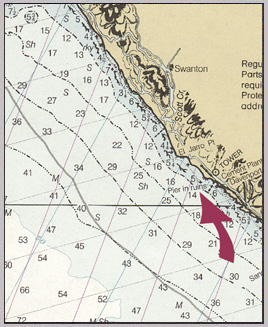 The first authenticated White Shark attack on a wind surfer off
the Pacific Coast of North America occurred on Thursday, 28 September
1995. Michael J. Sullivan, age 25, was attacked about 1 km off Davenport
Landing, about 24 km north of Santa Cruz, California (37°00.2’N:
122°12.3’W). His black wetsuit had purple accents, and
his 2.8-m sailboard was lime green with a clear Mylar sail and trimmed
with a red and black margin.
The first authenticated White Shark attack on a wind surfer off
the Pacific Coast of North America occurred on Thursday, 28 September
1995. Michael J. Sullivan, age 25, was attacked about 1 km off Davenport
Landing, about 24 km north of Santa Cruz, California (37°00.2’N:
122°12.3’W). His black wetsuit had purple accents, and
his 2.8-m sailboard was lime green with a clear Mylar sail and trimmed
with a red and black margin.
At 1730 hrs, the sky was clear, the result of a strong 20-knot
wind blowing from the northwest. This wind caused rough water, with
2-to-3-m “wind waves” on the sea surface. No pinnipeds
were seen in the water, although, according to Sullivan, they are
usually in the area. Several dense kelp canopies were 100 m south
and shoreward of the attack location, but there were no kelps in
the immediate area of Sullivan’s attack. This was the fifth
White Shark attack from this recurring location.
Sullivan and about a dozen other wind surfers were near the lower
reef at Davenport Landing, enjoying the excellent sailing conditions.
Sullivan had been sailing about 45 minutes. The wind had begun to
let up, so he turned to head back toward the beach. This maneuver
reduced his forward speed to about 6 knots. There was a light “thump”
to the back of his board as it lifted up underneath him.
Sullivan recalled, “I thought I hit a whale or maybe
a seal. The board coming up out of the water caused me to lose my
balance, and I fell into the water. I had dropped my sail in the
process of falling right on top of the shark’s back. The shark
began slapping its tail wildly, causing the water to be thrown up
in the air, maybe 15 feet [5 m]. I literally crawled off
the shark’s back and swam about 30 feet [10 m] before
I stopped to look back in the direction of my board.”
A wind surfing companion rode toward Sullivan, instructing him
to get back on his board. The water was swirling all around the
board following the shark’s hasty departure. Sullivan swam
to his board, which was upside down and oriented away from the beach.
He righted the board, climbed back on it, and headed for shore.
The fortunate wind surfer’s only injury was an abrasion to
the top of his right foot. Michael J. Sullivan and several who witnessed
the attack thought the White Shark was about 4 m in length.
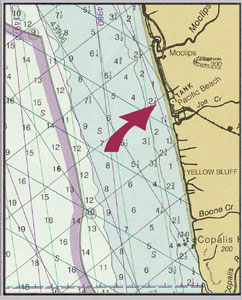 The
first authenticated shark attack for the state of Washington during
the Twentieth Century would occur on Wednesday, 12 April 1989. It
was probably like any other day to surfer Robert Harms as he sat
on his purple surfboard 100 m off Pacific Beach, near Aberdeen in
western Washington (47 12.7'N; 124 12.6'W). McCosker and Lea reported
that Harms, while lying prone on his board at 1045 hrs, felt a sharp
pain in his left arm. The surfer resisted a slight tug on his arm,
instinctively pulling it away from whatever had grabbed it. A large
swirl next to his surfboard drew Harms' attention to a large gray
fish. He gathered himself back onto his board and headed for shore. The
first authenticated shark attack for the state of Washington during
the Twentieth Century would occur on Wednesday, 12 April 1989. It
was probably like any other day to surfer Robert Harms as he sat
on his purple surfboard 100 m off Pacific Beach, near Aberdeen in
western Washington (47 12.7'N; 124 12.6'W). McCosker and Lea reported
that Harms, while lying prone on his board at 1045 hrs, felt a sharp
pain in his left arm. The surfer resisted a slight tug on his arm,
instinctively pulling it away from whatever had grabbed it. A large
swirl next to his surfboard drew Harms' attention to a large gray
fish. He gathered himself back onto his board and headed for shore.
Upon reaching the beach, he removed his wetsuit to treat the multiple
tooth punctures and lacerations. The wounds extended from his thumb
to mid-forearm, a distance of about 25 cm. A companion assisted
Harms in applying antiseptic cleanser and adhesive bandaging to
his wounds. Although somewhat shaken and withdrawn, Harms was not
taken to a medical facility. McCosker and Lea believed this to be
the first and, to date, only White Shark attack on a human to be
authenticated from the state of Washington. I suspect it will not
be the last.
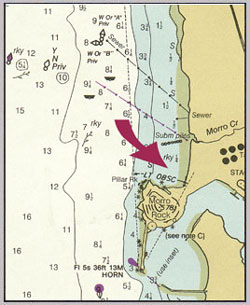 It
is not always possible to determine the species of shark responsible
for an attack. In fact, in a few cases reported during the Twentieth
Century there was a question as to whether a shark was even involved
in the incident. The following case history may be an example of
a shark's being blamed for an attack simply because sharks are known
to attack surfers — a case of "guilt by association." It
is not always possible to determine the species of shark responsible
for an attack. In fact, in a few cases reported during the Twentieth
Century there was a question as to whether a shark was even involved
in the incident. The following case history may be an example of
a shark's being blamed for an attack simply because sharks are known
to attack surfers — a case of "guilt by association."
Surfer John Buchanan, age 17, was presumably attacked on Sunday,
29 August 1982, at about 1020 hrs, 100 m north of the recurring
location Morro Rock at Morro Bay, San Luis Obispo County, California
(35 22.5'N; 120 52.0'W).
Buchanan was 50 m south of seven or eight surfers and about 100
m from the beach. Water visibility was 4 to 5 m. Buchanan recalled,
"The water was pretty clean." His board was more than
2 m in length, with a red bottom and sides. He was sitting up on
his board, his feet dangling from either side, when there was a
bump to the left front edge of the surfboard. He glanced down and
saw "the head of an animal, colored gray, with a slight cast
of brown. It looked smooth and somewhat pointed." The surfer
was knocked into the water and began thrashing wildly as he swam
toward the beach, some 75 m away. His surfboard was pulled about
10 m across the surface toward the open sea before it was released.
Buchanan regained his composure and, after abandoning his board,
caught a wave, body surfing to the beach. Unaware of his plight,
a fellow surfer, thinking he had been injured, swam out to retrieve
his board. Fortunately for this "Good Samaritan," the
assailant did not return.
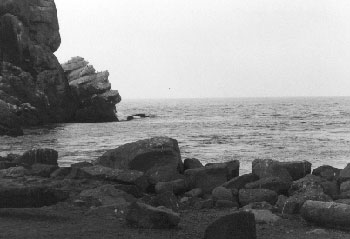 The
surfer did not receive any injuries, although he may have had shattered
nerves. The surfboard was a different story. There were two elongated
impressions, each 5 cm in length, with three smaller punctures and
one large circular indentation. These were the only marks to the
surfboard. Robert N. Lea, California Fish & Game, reported,
"On the day before there had been two shark sightings at
this beach. These could have been blue sharks, basking sharks, or
for that matter any other surface-dwelling shark. The species of
shark that attacked Buchanon's surfboard is unknown." The
surfer did not receive any injuries, although he may have had shattered
nerves. The surfboard was a different story. There were two elongated
impressions, each 5 cm in length, with three smaller punctures and
one large circular indentation. These were the only marks to the
surfboard. Robert N. Lea, California Fish & Game, reported,
"On the day before there had been two shark sightings at
this beach. These could have been blue sharks, basking sharks, or
for that matter any other surface-dwelling shark. The species of
shark that attacked Buchanon's surfboard is unknown."
Following an extensive background investigation into this case,
one additional suspect could be added to the list of possible culprits
- a pinniped. Buchanan's description of his attacker indicated:
"The animal had kind of a pointed head and was colored gray
with a hint of brown." A pinniped's snout is somewhat pointed,
and several species common to the Pacific Coast, including Harbor
Seals (Phoca vitulina richardsi), are colored gray/brown. The pinniped's
predominant whiskers might have been lying flat against its head
- a common behavior when sticking their heads quickly out of water
and playing with or biting objects. They are also known to frequently
harass surfers, including the ramming of their surfboards with such
force that the riders are sometimes knocked into the water. Finally,
Lea reported a circular indentation to the board's bottom.
After examining the dentition of sharks common to the Pacific
Coast, it was determined that none could replicate the damage reported
to the bottom of the surfboard by Lea. Comparisons were made with
the dentition from the following shark species: White (Carcharodon
carcharias), Blue (Prionace glauca), Shortfin Mako (Isurus oxyrinchus),
Sevengill (Notorynchus cepedianus) and Sixgill (Hexanchus griseus)
sharks. None replicated the documented damage sustained to the board.
However, the upper and lower canine teeth of a pinniped typically
produce circular impressions (holes) and have the appropriate spacing
to cause the ridges on the board, as described by Lea. Further,
California Department of Fish & Game spokesman Paul Chappell
was quoted in a local newspaper as saying: "Preliminary
investigation indicates…that the bite was not made by a shark.
The bite pattern does not look like a shark made it. It could have
been just a very playful seal. Harbor Seals are known to frequent
the area where the attack occurred." Ultimately, it was
not possible to determine what species of marine animal was responsible
for the attack on John Buchanan's surfboard.
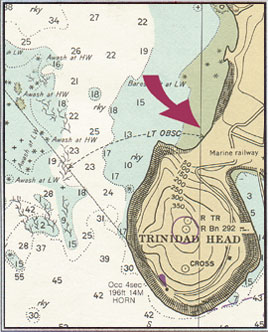 On
Tuesday, 28 August 1990, at 1650 hrs, 22-year-old, Rodney Swan was
attacked while surfing near Trinidad Head, north of Eureka in far
northwestern California (41 03.5'N; On
Tuesday, 28 August 1990, at 1650 hrs, 22-year-old, Rodney Swan was
attacked while surfing near Trinidad Head, north of Eureka in far
northwestern California (41 03.5'N;
124 09.0'W). He was 30 m from shore, adjacent to the north corner
of Trinidad Head. The water was 1 to 2 fm deep, with a temperature
of 14 C and visibility of 2 to 3 m. The sky was overcast, with an
air temperature of about 18 C and a northerly breeze causing a light
chop across the small groundswells. The ocean floor was sandy with
a few scattered sandbars and no visible kelp canopies present in
the immediate area. Several pinnipeds basked on nearby rocks and
barked from time to time, but displayed no unusual behavior. Swan
sat on his 2-m orange and white surfboard just off a rocky headland
where several pinnipeds were basking near the water's edge; no pinnipeds
were observed in the water. The waves were forming poorly for surfing
purposes, causing several of Swan's companions to go ashore in frustration.
Swan was dressed in a full black wetsuit.
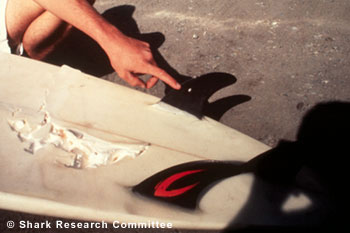 The
quiet of late afternoon was shattered suddenly by the sound of a
tremendous impact. A White Shark struck Swan's surfboard with such
force that the wind was knocked out of him as he was catapulted
1 to 2 m into the air before plunging into the water. Opening his
eyes underwater, he saw the flank of a large White Shark less than
1 m away. The shark was barely visible through the foaming, bubbling
water. The shark appeared to be 5 to 6 m in length, with a very
large girth. The
quiet of late afternoon was shattered suddenly by the sound of a
tremendous impact. A White Shark struck Swan's surfboard with such
force that the wind was knocked out of him as he was catapulted
1 to 2 m into the air before plunging into the water. Opening his
eyes underwater, he saw the flank of a large White Shark less than
1 m away. The shark was barely visible through the foaming, bubbling
water. The shark appeared to be 5 to 6 m in length, with a very
large girth.
Swan recalled, "My heart was just about to rip through
my rib cage. The shark must have felt it, because it was so close
to me I wanted to touch it. I really wanted to touch it. I thought,
if you're going to take my life, I at least want to touch you. I
surfaced in the churning, bubbling water and just floated, numb
and winded, waiting for the shark to finish me off. As I floated
on the surface trying to catch my breath, I said several prayers.
Time was like maple syrup, just moving so slowly. I felt like I
was in a totally different world, like everything had stopped, but
I was still going." Swan caught his breath, climbed on
his board and paddled to the beach.
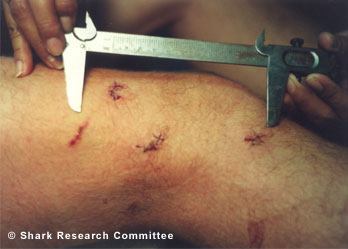 The
attacking White Shark had come from the southwest, between the surfer
and the nearby rocky headland. It had struck the left underside
of the board with its snout, leaving a distinct dent. The shark
then circled around and removed a bite from the right rear of the
surfboard, simultaneously inflicting a single deep laceration to
the surfer's right leg. Upon his reaching shore, Swan's companions
on the beach assisted him to a car and drove him to Mad River Community
Hospital in Arcata. The
attacking White Shark had come from the southwest, between the surfer
and the nearby rocky headland. It had struck the left underside
of the board with its snout, leaving a distinct dent. The shark
then circled around and removed a bite from the right rear of the
surfboard, simultaneously inflicting a single deep laceration to
the surfer's right leg. Upon his reaching shore, Swan's companions
on the beach assisted him to a car and drove him to Mad River Community
Hospital in Arcata.
Upon Swan's admittance to the hospital's emergency room, physician
Preston Smith examined the surfer. Smith cleaned and sutured four
individual tooth punctures. Prescriptions for antibiotics and painkillers
were given to Rodney Swan along with instructions for follow-up
treatment with his family physician. He was expected to make a complete
and uneventful recovery.
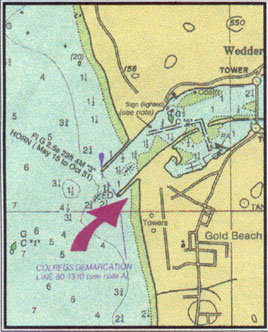 Within
a month of Keith Caruso's attack, surfer Jerad Brittain, age 20, would
be struck by a White Shark. Brittain was attacked on Sunday, 13 September
1992, at 1700 hours, 50 meters from shore, near the jetty at Gold Beach, Curry
County, in far southwestern Oregon (42°25.1'N; 124°25.8'W). Journalists
John Griffith, of The Oregonian in Portland, and Greg Haas, of the Curry
Coastal Pilot in Brookings, generously provided some of the information
for the following incident. Within
a month of Keith Caruso's attack, surfer Jerad Brittain, age 20, would
be struck by a White Shark. Brittain was attacked on Sunday, 13 September
1992, at 1700 hours, 50 meters from shore, near the jetty at Gold Beach, Curry
County, in far southwestern Oregon (42°25.1'N; 124°25.8'W). Journalists
John Griffith, of The Oregonian in Portland, and Greg Haas, of the Curry
Coastal Pilot in Brookings, generously provided some of the information
for the following incident.
Brittain was surfing with his brother, Jeff, about 20 meters from the Gold
Beach South Jetty, adjacent to the mouth of the Rogue River. Brittain
recalled, "I was sitting upright on my surfboard, with my brother
located halfway between me and the jetty. I noticed that all the seals
I had seen just a few minutes earlier were now gone. Then all of a sudden,
while still sitting on my board, I felt this massive jerk on my leash."
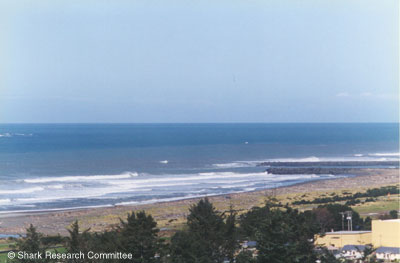 The
shark had grabbed the leg leash and began slapping the water with its
tail, striking both the surfer and his board. The attacking shark pulled
Brittain off his board as it headed seaward. The surfer began striking
his assailant with a clenched fist as it pulled him along the surface.
During this struggle, the surfer saw the shark's dorsal fin and tail,
estimating the distance between them to be 2 to 2.5 meters. Within seconds,
the shark's teeth cut the leg leash, allowing Brittain to gulp a breath
of air as he swam toward the beach. He described the shark's color as
dark gray on the back, with a white underbelly. The surfer was fortunate
to receive only several bruises. This was the fourth attack at this
recurring location. The attacking White Shark was 4 to 5 meters in length. The
shark had grabbed the leg leash and began slapping the water with its
tail, striking both the surfer and his board. The attacking shark pulled
Brittain off his board as it headed seaward. The surfer began striking
his assailant with a clenched fist as it pulled him along the surface.
During this struggle, the surfer saw the shark's dorsal fin and tail,
estimating the distance between them to be 2 to 2.5 meters. Within seconds,
the shark's teeth cut the leg leash, allowing Brittain to gulp a breath
of air as he swam toward the beach. He described the shark's color as
dark gray on the back, with a white underbelly. The surfer was fortunate
to receive only several bruises. This was the fourth attack at this
recurring location. The attacking White Shark was 4 to 5 meters in length.
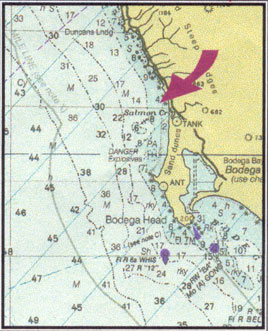 Surfer Kennon Cahill, age 31, was attacked by a 5-m White Shark, on Thursday, 3 October 1996, while surfing at North Salmon Creek Beach, near Bodega Bay, Sonoma County, California (38°21.9'N; 123°04.5'W). He was dressed in a full-body, hooded black neoprene wetsuit with booties and rode a 2-meter white surfboard. The sky was overcast and foggy with the air and water temperature about 12°C. The ocean was "glassy smooth," with a rhythmic groundswell of less than a meter and underwater visibility of 5 to 6 meters. At the attack site the ocean floor is generally sandy, with a few scattered rocks but no dominant kelps. A channel runs from the creek out toward the open sea, then turns parallel to the shoreline for several hundred meters. Surfer Kennon Cahill, age 31, was attacked by a 5-m White Shark, on Thursday, 3 October 1996, while surfing at North Salmon Creek Beach, near Bodega Bay, Sonoma County, California (38°21.9'N; 123°04.5'W). He was dressed in a full-body, hooded black neoprene wetsuit with booties and rode a 2-meter white surfboard. The sky was overcast and foggy with the air and water temperature about 12°C. The ocean was "glassy smooth," with a rhythmic groundswell of less than a meter and underwater visibility of 5 to 6 meters. At the attack site the ocean floor is generally sandy, with a few scattered rocks but no dominant kelps. A channel runs from the creek out toward the open sea, then turns parallel to the shoreline for several hundred meters.
Cahill and his companion, Brendon Guinn, were surfing about 125 to 150 meters from the beach. Relative to Guinn, Cahill was 6 to 10 meters farther out to sea and 15 meters farther north. Guinn checked his watch to confirm that he would not be late for work. It was 0719 hours when Guinn turned to the north to tell Cahill he was heading in. Cahill's board was pointed toward Guinn when he saw, on the shoreward side of his companion's board, a dorsal fin protruding from the water at least 45 centimeters, and only 1 meter from the board. The fin tipped slowly over, away from the board, to an angle of 45 degrees. It appeared to Guinn as though the shark had rolled to better observe Cahill.
Guinn recalled what happened next: "Cahill, as if in a trance, had crouched on his board and was reaching out with his left hand, like he was going to try and grab the shark's fin. It only took a second or two before Cahill drew his arm back in to his chest and let out a loud groan, as his board rocked back and forth. The shark reacted almost immediately by rolling toward Cahill as it came out of the water like a nuclear submarine. Cahill started yelling, 'Shark! Shark!' as the shark thrashed its tail back and forth four or five times, striking the surfboard at least two or three times with its head. Then it appeared that Cahill was trying to ride his board over the shark's back toward the beach. I turned and started paddling toward shore."
While heading in, Guinn turned to his left to try to locate his companion. Cahill suddenly passed him, riding his board all the way through the surf until it ran aground in shallow water. Witnesses on the beach said the shark followed Cahill to within 30 meters of the beach as it repeatedly tried to strike his board. Neither Kennon Cahill nor Brendon Guinn suffered any physical injury, although Park Ranger Michael Wisehart said, "Both surfers were badly shaken by the experience." This was the second attack from this recurring location.
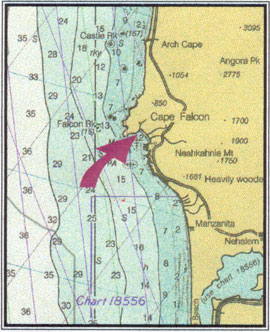 On
Wednesday, 21 September 1994, surfer Rob MacKenzie was attacked by a
White Shark at Short Sand Beach, located in Oswald West State Park between
Arch Cape and Manzanita, near Seaside in far northwestern Oregon (45°45.5'N;
123°58.4'W). He was dressed in a black wetsuit with boots and without
a hood. The ocean was glassy calm with gently rolling 1-meter groundswells
and a temperature of about 14ºC. The water was not very clear,
with visibility of about 2 meters. The ocean floor was 2 fathoms deep, primarily
sandy with a rocky reef at the base of the Basalt Headlands. The sky
was sunny and cloudless, with a light breeze and a temperature of 18ºC.
No pinnipeds were seen at this location. It was about 1630 hours as MacKenzie
sat atop his 2-meter yellow surfboard, 70 meters from the beach. On
Wednesday, 21 September 1994, surfer Rob MacKenzie was attacked by a
White Shark at Short Sand Beach, located in Oswald West State Park between
Arch Cape and Manzanita, near Seaside in far northwestern Oregon (45°45.5'N;
123°58.4'W). He was dressed in a black wetsuit with boots and without
a hood. The ocean was glassy calm with gently rolling 1-meter groundswells
and a temperature of about 14ºC. The water was not very clear,
with visibility of about 2 meters. The ocean floor was 2 fathoms deep, primarily
sandy with a rocky reef at the base of the Basalt Headlands. The sky
was sunny and cloudless, with a light breeze and a temperature of 18ºC.
No pinnipeds were seen at this location. It was about 1630 hours as MacKenzie
sat atop his 2-meter yellow surfboard, 70 meters from the beach.
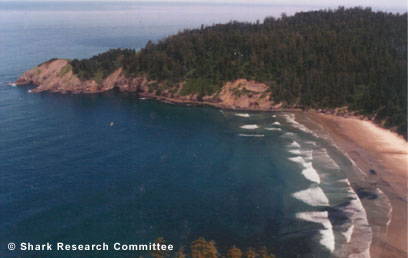 MacKenzie
and companion Greg Movsesyan had been surfing for about 75 minutes when
they stopped to watch a Gray Whale (Eschrichtius robustus) breaching
about 1.6 kilometers offshore. About a dozen other surfers were spread out along
the 1.6 kilometer-long beach within the sheltered cove. MacKenzie
and companion Greg Movsesyan had been surfing for about 75 minutes when
they stopped to watch a Gray Whale (Eschrichtius robustus) breaching
about 1.6 kilometers offshore. About a dozen other surfers were spread out along
the 1.6 kilometer-long beach within the sheltered cove.
Movsesyan reported, "I noticed a gray form passing diagonally
under my board which, because I had surfed often with dolphins in California,
didn't alarm me. The form approached Rob [MacKenzie] less than
15 feet [5 meters] away and, before I could say anything, it surfaced
and bumped the side of Rob's board about three-quarters of the way forward.
Rob went flying into the air, still attached to his board by a seven-foot
[about 2-meters] leash, and came down in the water just in front of the
shark. The board had become impaled sideways on the shark's lower jaw
and, to dislodge it, the shark raised its back half out of the water
and slammed its head on the surface until the board floated free. Then
the shark dived, getting its tail caught on the leash and pulling Rob
and his board under as it swam for deeper water. Under the strain, the
leash broke, shooting the board high in the air and allowing Rob to
surface and retrieve it. We headed for shore, paddling until we reached
waist-deep water. Rob had not been bitten and his wetsuit had only a
graze-mark on the right hamstring, presumably from a shark tooth. We
were both in a state of utter calm, while the beach-goers and the other
surfers were reacting in a great frenzy."
In a letter dated 8 May 2000, Movsesyan described the damage to MacKenzie's
board. According to Movsesyan, an arc of lower-tooth impressions, measuring
35 centimeters across at their widest, punctured the bottom of his companion's
board. The mid-line of the arc, corresponding to the center of the shark's
jaw, was located near the front of the board, about a third of the distance
along its overall length. Movsesyan described the attacking White Shark
as about 5 meters in length. Rob MacKenzie was fortunate to escape without
injury.
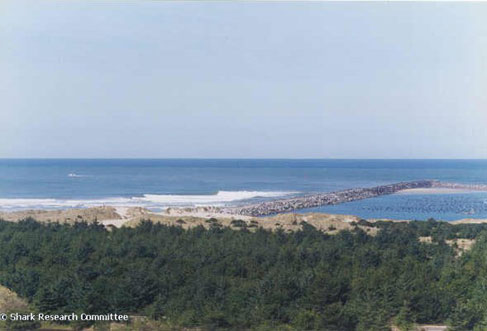 |
|
Winchester Bay South
Jetty |
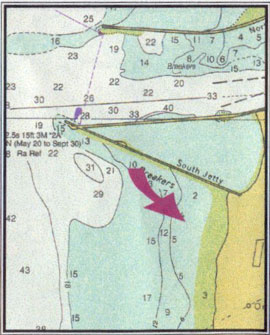
On Tuesday, 24 August 1976, at 1400 hours, surfer Mike Shook, age 19, was
attacked by a White Shark at Winchester Bay in west central Oregon (43
39.8. N; 124 12.8. W). Shook was 100 meters from the beach and 50 meters south
of the jetty in water 1 to 2 fathoms deep. The sky was overcast, with a light
breeze. There was a small groundswell, and water visibility equaled the
depth, as the bottom could be seen clearly from the surface. Shook had
been surfing about 45 minutes and had not observed any pinnipeds near
him.
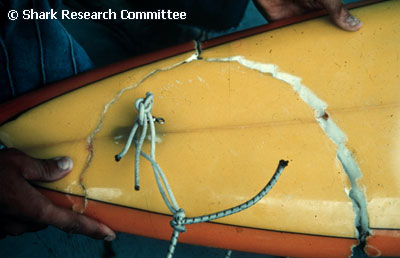
Shook was lying on his board attempting to catch a
wave when he felt a slight bump to the rear of the board. This was
quickly followed by a more forceful jolt, which caused the surfer to
glance back. Much to his surprise, a large White Shark had the rear of his
surfboard in its mouth. The shark swam along the surface, pushing the
board and rider 5 to 10 meters before the end of the board broke off in the
shark's mouth. The shark released the piece of board it had broken off,
then submerged out of sight. Shook swam toward the jetty with the broken
end of his board attached to his ankle leash. The White Shark was
estimated at 4 to 5 meters in length. Shook was not injured.
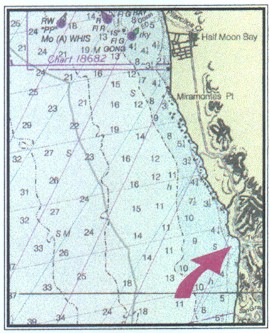 On
Saturday, 15 August 1987, Craig Rogers, age 40, was attacked by a White
Shark while surfing off Tunitas Creek, near Half Moon Bay, San Mateo
County, California (37°21.6' N; 122°24.5' W). His surfboard was 2.1
meters in length, square-tailed, and colored white with numerous decals.
It was 0730 hours, with an overcast sky and an air temperature of 18°C.
He was 200 meters from shore in murky water 3 to 4 fathoms deep, with visibility
of 1 meter and a temperature of about 15°C. The ocean floor was sandy, and
there were no marine mammals observed in the area before or following
the incident. On
Saturday, 15 August 1987, Craig Rogers, age 40, was attacked by a White
Shark while surfing off Tunitas Creek, near Half Moon Bay, San Mateo
County, California (37°21.6' N; 122°24.5' W). His surfboard was 2.1
meters in length, square-tailed, and colored white with numerous decals.
It was 0730 hours, with an overcast sky and an air temperature of 18°C.
He was 200 meters from shore in murky water 3 to 4 fathoms deep, with visibility
of 1 meter and a temperature of about 15°C. The ocean floor was sandy, and
there were no marine mammals observed in the area before or following
the incident.
Rogers had been surfing only five minutes and
was sitting on his board, legs dangling off either side. His hands
were on each rail just in front of his legs as he gazed appreciatively
out toward the horizon. Rogers' surfing companion, Tim Burraston,
was 200 meters south of him. Rogers had been perched on his slowly
rolling surfboard for several minutes when he noticed that his board
had suddenly, but almost imperceptibly, stopped moving in the water.
Without moving his head, he lowered his eyes, coming to focus on
the head and eye of a "huge" shark. The shark had gently
grasped the surfboard, just millimeters in front of his left hand.
Rogers thought he and the shark remained frozen, almost motionless,
for several seconds. They both seemed to release their respective
grips simultaneously, with the little and ring fingers of Rogers'
left hand striking the protruding teeth of the shark's upper jaw.
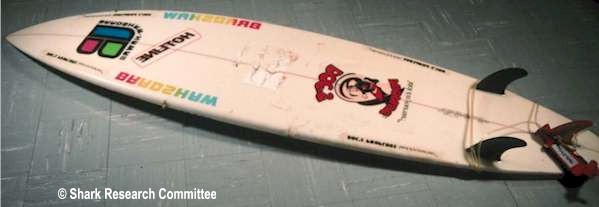
After releasing his grip, Rogers slid off the
right rear of his board and grabbed its edge with both hands. With
only his head protruding above the water, he watched as the shark
held the board firmly in its mouth for several seconds before finally
releasing its hold and submerging. As soon as the shark relinquished
its grip, the surfer climbed back on his board. As water swirled
all around him, Rogers watched the shark submerge and swim beneath
his board. Straining to be heard above the roaring surf, he yelled
to his friend that a shark had attacked him. It was several seconds
before Burraston realized what had happened. Rogers caught a wave
and held on until his board "bottomed out" in the surf.
|
|
| Rogers and his companion drove to Emerge-Care Medical
Clinic in Santa Cruz. Dr. Stanley Hajduk treated the surfer's wounds,
which required seven sutures. The wounds were cleaned and dressed and
antibiotics were prescribed. According to his physician, the surfer
was expected to regain complete control of his fingers and hand
without any permanent impairment. |
 |
|
|
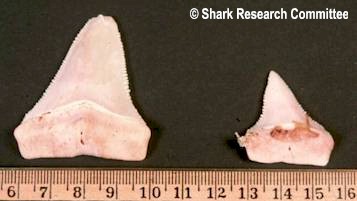 |
During its gentle contact with Rogers' surfboard, the shark left its
"calling card" in the form of two whole teeth. In addition,
the impressions left by the shark's teeth were easily identifiable
by their spacing. This permitted a reliable size estimate for
the attacking White Shark at 5.7 meters in length. The surfboard,
with accompanying White Shark teeth, is currently in a surfing
museum in Santa Cruz. |
If you, or someone you know, has been involved in a shark attack and would
like to voluntarily participate in the Shark Research Committee's research
program, please use the appropriate reporting form.
|
